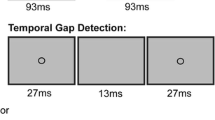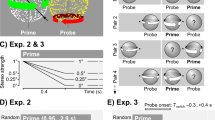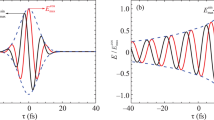Abstract
A briefly pulsed light is brighter than a pulse of longer duration. For a brief flash of fixed duration and small area, enlarging a target results initially in an increase in brightness. Beyond some critical area, the target dims with further increases in size. These two phenomena are the temporal and the spatial Broca-Sulzer effect respectively. Each effect can be modeled using a generalization of the Hartline-Ratliff equation. The resulting analysis produces a mathematically unified treatment of both effects.
Similar content being viewed by others
References
Arend, L.E., Jr.: Contour factors in the Broca-Sulzer phenomenon (Doctoral dissertation, Duke University). Dissertation Abstracts International 32/02-B, 1231 (1970)
Arend, L.E., Jr.: Spatial factors in the Broca-Sulzer phenomenon. J. Opt. Soc. Am. 63, 879–883 (1973)
Barlow, H.B.: Temporal and spatial summation in human vision at different background intensities. J. Physiol. 141, 337–350 (1958)
Barlow, H.B., Fitzhugh, R., Kuffer, S.: Change of organization in the receptive fields of the cat's retina during dark adaptation. J. Physiol. 137, 338–354 (1957)
Baron, W.S., Westheimer, G.: Visual acuity as a function of exposure duration. J. Opt. Soc. Am. 63, 212–219 (1973)
Bartley, S.H.: Subjective brightness in relation to flash rate and the light-dark ratio. J. Exp. Psychol. 23, 313–319 (1938)
Berman, S.M., Stewart, A.L.: Laterally induced impedance effects in vision. J. Math. Psychol. 18, 73–99 (1978a)
Berman, S.M., Stewart, A.L.: The mathermatical theory of lateral impedance of visual activity and an application of Markov processes. Biol. Cybernetics 30, 99–108 (1978b)
Boynton, R.M.: Some temporal factors in vision. In: Sensory communication. Rosenblith, W.A., (ed.) Cambridge, Mass.: M.I.T. 1961
Broca, A., Sulzer, D.: La sensation lumineuse en fonction du temps. J. Physiol. Path. Gen. 4, 632–640 (1902)
Broca, A., Sulzer, D.: Sensation lumineuse en fonction du temps pour les lumières colorées. Techniques et résultats. C.R. Acad. Sci. (Paris) 137, 944–946 (1903a)
Broca, A., Sulzer, D.: Rôle du temps dans la comparaison des éclats lumineux en lumière colorée. C.R. Acad. Sci. (Paris) 137, 977–979 (1903b)
Broca, A., Sulzer, D.: La sensation lumineuse en fonction du temps pour les lumières colorées. Discussion des résultats. C.R. Acad. Sci. (Paris) 137, 1046–1049 (1903c)
Broca, A., Sulzer, D.: La sensation lumineuse en fonction du temps pour les lumières colorées. Expériences avec les milieux absorbants. J. Physiol. Path. Gen. 6, 55–68 (1904)
Davidson, M.L.: A perturbation analysis of spatial brightness interaction in flashed visual fields (Doctoral dissertation, University of California, Berkeley). Dissertation Abstracts International 27/08-B, 2888 (1966)
Davidson, M.L.: Perturbation approach to spatial brightness interaction in human vision. J. Opt. Soc. Am. 58, 1300–1308 (1968)
Hadeler, K.P.: On the theory of lateral inhibition. Kybernetik 14, 161–165 (1974)
Higgins, K.E., Rinalducci, E.J.: Suprathreshold intensity-area relationships: A spatial Broca-Sulzer effect. Vision Res. 15, 129–143 (1975)
Limb, J.O., Rubinstein, C.B.: A model of threshold vision incorporating inhomogeneity of the visual field. Vision Res 17, 571–584 (1977)
Mansfield, R.J.W.: Brightness function: Effect of area and duration. J. Opt. Soc. Am. 63, 913–920 (1973)
Marks, L.E.: Sensory processes. New York: Academic Press 1974
Smithies, F.: Integral equations, Cambridge: Cambridge University 1958
Van Doorn, A.J., Koenderink, J.J., Bouman, M.A.: The influence of the retinal inhomogeneity on the perception of spatial patterns. Kybernetik 10, 223–230 (1972)
Walters, J.W., Harwerth, R.S.: The mechanism of brightness enhancement. Vision Res. 18, 777–779 (1978)
Wasserman, G.S.: Brightness enhancement in intermittent light: Variation of luminance and light-dark ratio. J. Opt. Soc. Am. 56, 242–250 (1966)
Wasserman, G.S., Kong, K.-L.: Illusory correlation of brightness enhancement and transients in the nervous system. Science 84, 911–913 (1974)
White, T.W.: Masking, acuity, latency and the scotopic Broca-Sulzer effect (Doctoral dissertation, University of Virginia). Dissertation Abstracts International 36/07-B, 3659 (1975)
Willmer, E.N.: Subjective brightness and size of field in the central fovea. J. Physiol. 123, 315–323 (1954)
Wilson, H.R., Giese, S.C.: Threshold visibility of frequency gradient patterns. Vision Res. 17, 1177–1190 (1977)
Author information
Authors and Affiliations
Rights and permissions
About this article
Cite this article
Berman, S.M., Stewart, A.L. A unified model for the combined temporal and spatial Broca-Sulzer effect. Biol. Cybernetics 34, 171–179 (1979). https://doi.org/10.1007/BF00336968
Received:
Issue Date:
DOI: https://doi.org/10.1007/BF00336968




